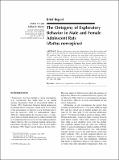Files in this item
The ontogeny of exploratory behavior in male and female adolescent rats (Rattus norvegicus)
Item metadata
| dc.contributor.author | Lynn, D. A. | |
| dc.contributor.author | Brown, Gillian Ruth | |
| dc.date.accessioned | 2010-12-21T14:13:02Z | |
| dc.date.available | 2010-12-21T14:13:02Z | |
| dc.date.issued | 2009-09 | |
| dc.identifier | 402392 | |
| dc.identifier | 2a70b7ad-d69e-47cd-b06f-f909f1e9ec48 | |
| dc.identifier | 000269599700006 | |
| dc.identifier | 70349382879 | |
| dc.identifier.citation | Lynn , D A & Brown , G R 2009 , ' The ontogeny of exploratory behavior in male and female adolescent rats ( Rattus norvegicus ) ' , Developmental Psychobiology , vol. 51 , no. 6 , pp. 513-520 . https://doi.org/10.1002/dev.20386 | en |
| dc.identifier.issn | 0012-1630 | |
| dc.identifier.other | ORCID: /0000-0002-0675-0780/work/60195735 | |
| dc.identifier.uri | https://hdl.handle.net/10023/1643 | |
| dc.description | Supported by Wellcome Trust grant 078405/Z/05/Z | en |
| dc.description.abstract | During adolescence, rats gain independence from their mothers and disperse from the natal burrow, with males typically dispersing further than females. We predicted that, if dispersal patterns are associated with responsiveness to novelty, exploratory behavior in novel environments would increase across adolescence, and males would explore more than females. Alternatively, females might explore more than males, if females are more motivated than males to learn about the immediate environment or if females have poorer spatial abilities than males. Twenty-five male and 21 female rats were exposed to two novel environments (open field and elevated plus-maze) during early, mid-, or late adolescence. Total locomotion and amount of exploration directed towards aversive areas increased across adolescence, even when body weight was included as a covariate. Female adolescents locomoted more and spent more time exploring aversive areas than males. Developmental changes in neural function potentially underlie age and sex differences in exploratory, behavior (C) 2009 Wiley Periodicals, Inc. Dev Psychobiol 51: 513-520, 2009. | |
| dc.format.extent | 8 | |
| dc.format.extent | 174350 | |
| dc.language.iso | eng | |
| dc.relation.ispartof | Developmental Psychobiology | en |
| dc.subject | Adolescence | en |
| dc.subject | Exploration | en |
| dc.subject | Novelty | en |
| dc.subject | Rats | en |
| dc.subject | Sex differences | en |
| dc.subject | Elevated plus-maze | en |
| dc.subject | Open-field behavior | en |
| dc.subject | Anxiety-related behavior | en |
| dc.subject | Sex-differences | en |
| dc.subject | Emotional behavior | en |
| dc.subject | Gender-differences | en |
| dc.subject | Risk-taking | en |
| dc.subject | Fear | en |
| dc.subject | Age | en |
| dc.subject | Depression | en |
| dc.subject | QL Zoology | en |
| dc.subject.lcc | QL | en |
| dc.title | The ontogeny of exploratory behavior in male and female adolescent rats (Rattus norvegicus) | en |
| dc.type | Journal article | en |
| dc.contributor.sponsor | The Wellcome Trust | en |
| dc.contributor.institution | University of St Andrews. School of Psychology and Neuroscience | en |
| dc.identifier.doi | https://doi.org/10.1002/dev.20386 | |
| dc.description.status | Peer reviewed | en |
| dc.identifier.url | http://www.scopus.com/inward/record.url?scp=70349382879&partnerID=8YFLogxK | en |
| dc.identifier.url | http://onlinelibrary.wiley.com/doi/10.1002/dev.20386/abstract | en |
| dc.identifier.grantnumber | 078405/Z/05/Z | en |
This item appears in the following Collection(s)
Items in the St Andrews Research Repository are protected by copyright, with all rights reserved, unless otherwise indicated.

